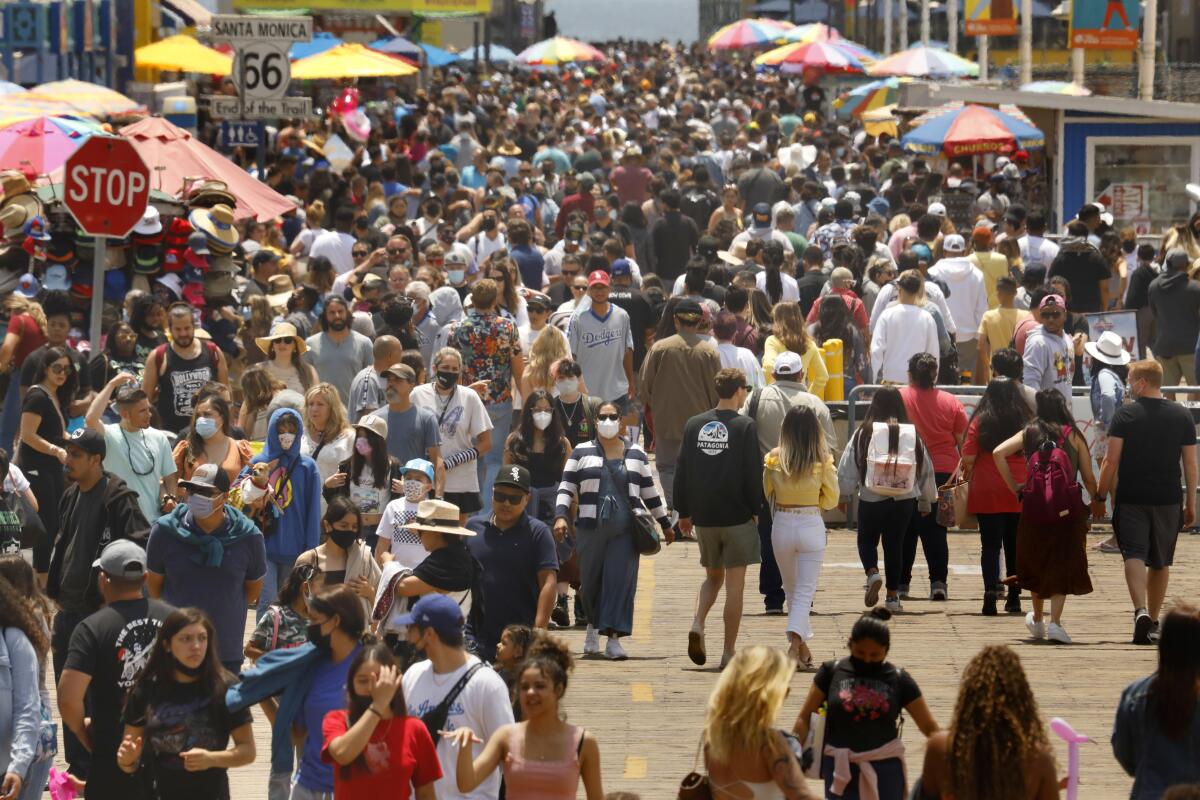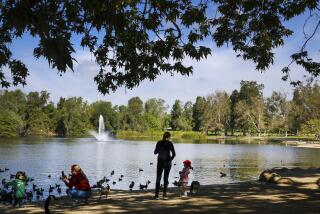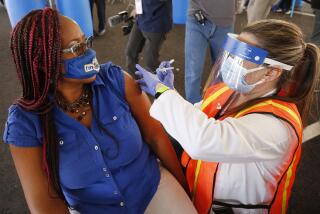What could go wrong as California reopens: Variants, vaccine skepticism, inequities

- Share via
Many public health experts are highly optimistic as California is set to fully reopen its economy Tuesday, ending most COVID-19 restrictions. But what could still go wrong?
There’s plenty of reason for confidence in the months to come. California has one of the highest rates of vaccination in the nation, with 56% of residents of all ages — and 72% of adults — having had at least one dose of vaccine.
The state has one of the lowest daily coronavirus case rates in America. California’s average number of daily coronavirus cases over a seven-day period are down 98% from their peak, and COVID-19 hospitalizations and average daily deaths are down 96%. Daily cases, deaths and hospitalizations are the lowest they’ve been since the first few weeks of the pandemic more than 14 months ago.
Barring a new, completely unforeseen development, experts do not anticipate California will backslide to any degree similar to the state’s previous three pandemic surges. There’s increasing evidence the vaccines are effective against known variants.
Still, public health experts say there are things to watch out for in the coming weeks and months that could interrupt the progress.
In places with low vaccination rates, “we’re gonna see outbreaks,” said Dr. Mark Ghaly, California Health and Human Services secretary.
“I have no doubt that we’ll see some places that are [largely] unvaccinated that are going to have an outbreak,” Ghaly said in a recent talk with the Public Policy Institute of California, “and that’s going to have real consequences.”
Here are some possible scenarios health experts will be watching for in the coming months:
Delta variant finds unvaccinated people
For people who are still unvaccinated, experts are increasingly concerned about the danger posed by the Delta variant of the coronavirus, first detected in India.
“If you’re fully vaxxed, I wouldn’t be too worried, especially if you’re in a highly vaxxed region. If you’re not vaccinated: I’d be afraid. Maybe even very afraid,” tweeted Dr. Robert Wachter, chair of UC San Francisco’s Department of Medicine.
Unvaccinated people may be able to avoid the virus in the summer but will be at higher risk in the autumn and winter if coronavirus transmission rates pick up among unvaccinated people.
The Delta variant “appears to be even more infectious” than the Alpha variant, first identified in the U.K. and now dominant in California and the U.S., Wachter said. Compared with some of the earliest conventional strains of the coronavirus, the Alpha variant is 40% more infectious, but the Delta variant is 40% more infectious than that, Wachter wrote.
Not only might the Delta variant be more likely to infect an unvaccinated person, but it also could cause more serious illness, “though we need more data to be sure,” according to Wachter.
“Delta has made me nervous: I’ll now bet we’ll see significant ... surges this fall in low-vaccine populations due to combo of seasonality, Delta’s nastiness, & ‘back to normal’ behavior,” Wachter wrote.
This scenario is not assured. It’s possible vaccination rates will be high enough that herd immunity will be achieved, interrupting transmission of the virus.
“Every person vaccinated helps protect against the Delta variant — the one, big remaining challenge that lies ahead to achieve containment,” tweeted Dr. Eric Topol, director of the Scripps Research Translational Institute in La Jolla.
Some areas never achieve herd immunity
Some areas of California have vaccination rates that lag far behind the statewide figure. Although 56% of Californians are at least partially vaccinated, some counties lag behind, including Riverside (45%); San Bernardino (42%); Merced (39%); Tulare and Kern (38%); and Kings (31%).
Many rural Northern California counties also have a low rate, such as Siskiyou (40%), Shasta (36%), Yuba (34%), Tehama (30%) and Lassen (21%).
One concern is whether enough farmworkers are being vaccinated. There have been targeted programs, but a number of farmworkers still haven’t received their shots. And because farmworkers move long distances to harvest one of the nation’s largest supplies of fruits and vegetables, getting them vaccinated should be a top priority for public health officials.
“There are still some communities that, because of their level of vaccination penetration, have some work to do,” Ghaly said. “We may see some outbreaks. We may see some number of people hospitalized.”
Dr. Kirsten Bibbins-Domingo, chair of the UC San Francisco Department of Epidemiology and Biostatistics, recently tweeted that more needed to be done to increase vaccine access, especially in places where the nearest vaccine site is more than 30 minutes away by public transportation and in areas where people have a high social vulnerability.
She recently tweeted an image showing counties where there were large numbers of unvaccinated people who wanted to be vaccinated. They extend from Imperial County at the Mexican border, through the Inland Empire and the Antelope Valley to the Central Valley, Salinas Valley, Santa Barbara County and rural Northern California.
Young Black and Latino residents remain unvaccinated
Officials are concerned that vaccination progress could stall in areas where too few people have received their shots.
In Los Angeles County, Public Health Director Dr. Barbara Ferrer has voiced concern about how far behind the youngest eligible Black and Latino residents are in receiving vaccinations. Among the youngest adults under age 30, just 25% of Black and 39% of Latino residents have received at least one shot, while 55% of white, 54% of Native American and 72% of Asian American residents are at least partially vaccinated.
In the last month, the pace at which Latino and Black residents of L.A. County have been vaccinated is a bit better than for white and Asian American residents. But, Ferrer warned, “we also need to be honest with ourselves.” That pace doesn’t “represent the momentum needed to reduce the possibility of outbreaks stemming from events where there are a large number of [unvaccinated] people present.”
But there is one sign of promise: The relative gap in vaccinations among seniors, by race and ethnicity, has shrunk considerably. Now, 65% of Black and 74% of Latino seniors in L.A. County have received at least one dose of vaccine. Among white seniors, 78% are at least partially vaccinated; among Native American seniors, 67%; and among Asian American seniors, 79%.
Health experts believe slower rates of vaccination are influenced by difficulty accessing vaccine clinics and personal hesitancy in deciding whether to get the vaccine.
It’s possible the disparities may shrink as the weeks go by and officials intensify efforts to bring clinics to underserved areas and workplaces that request vaccine clinics. For workers trying to make ends meet by working multiple jobs, free time is limited and on-the-job shots can dramatically improve vaccination rates.
Word-of-mouth assurances also help, Ferrer said. People see “friends getting vaccinated; you see other family members getting vaccinated, and you hear from people you trust that the vaccines are in fact safe and effective, and that helps move people ... to getting vaccinations.”
San Francisco has shown it’s not impossible to reduce vaccination disparities.
In the city, 67% of Latino residents have received at least one vaccine dose — a rate slightly better than that of white residents, with 64% at least partially vaccinated, according to data released by local officials. Fifty-six percent of San Francisco’s Black residents have been vaccinated with at least one dose, as have 75% of Asian Americans.
In San Francisco’s heavily Latino Mission District, 72% of residents are vaccinated, according to the city, slightly better than the citywide rate of 70% of residents who have had at least one dose.
In a legislative committee hearing in May, Dr. Tomás Aragón, the former San Francisco health officer who is now the state health officer and director of the California Department of Public Health, detailed the extensive vaccination outreach in the Mission District.
At St. Peter’s Church, priests at Spanish-language services asked congregants if they’d been vaccinated. If they hadn’t, they were told, they could register just outside the church doors for a vaccine appointment.
Some community members went door-to-door in commercial business districts, telling workers they were there to register them for a vaccine clinic.
And a centrally located vaccine clinic was designed to be welcoming to its target community. Music was on offer, and people receiving vaccinations were asked if they needed any support — and if there was anyone at home who hadn’t yet been vaccinated.
“Community members that are getting vaccinated are the best ambassadors for getting vaccinated,” Aragón said, “because they can go home and bring people bring people back.”
More to Read
Sign up for Essential California
The most important California stories and recommendations in your inbox every morning.
You may occasionally receive promotional content from the Los Angeles Times.












